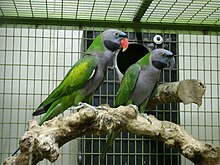Lord Derby's parakeet
| Lord Derby's parakeet | |
|---|---|

| |
| A pair - male on left and female on right | |
| Scientific classification | |
| Domain: | Eukaryota |
| Kingdom: | Animalia |
| Phylum: | Chordata |
| Class: | Aves |
| Order: | Psittaciformes |
| Family: | Psittaculidae |
| Genus: | Psittacula |
| Species: | P. derbiana
|
| Binomial name | |
| Psittacula derbiana | |
Lord Derby's parakeet (Psittacula derbiana), also known as Derbyan parakeet, is a parrot species,
The name of this bird commemorates
Lord Derby's parakeets feed on fruits, berries, seeds, and leaf buds, occasionally foraging in gardens and fields.
Description

Lord Derby's parakeets are 45–50 cm (18–20 in) in length and are
Immature Lord Derby's parakeets are duller in colour than the adults. Juvenile birds have green crowns, orange-red upper and lower mandible (beak), and their irises are dark and do not lighten until they reach maturity between two and three years of age.
Sexual dimorphism
- Adult male
-
The adult male has a red upper mandible
-
Male
-
Male pet kept in China
- Adult female
-
A female pet in Tibet. The adult female has an all black beak.
-
A female pet in China
-
A captive female in China
Reproduction

Breeding season usually begins between April and June. The female lays a clutch of two to four eggs (36.1 mm × 27.7 mm [1.42 in × 1.09 in]) in nest holes of trees. The young hatch after an incubation period of about 23 days and will fledge after 8 to 9 weeks.
Divergence
It was discovered that the divergence of Psittacula from other parrots occurred between 3.4 and 9.7 million years ago and divergence in Psittacula occurred between 2.5 and 7.7 million years ago. However, the divergence of derbyan parakeet occurred most recently between 0.2 and 0.5 million years ago.[4]
References
- ^ . Retrieved 13 November 2021.
- ^ In Proceedings of the Zoological Society of London, 1850, p. 245 and plate Aves XXV, published on 24 Jan 1852 (see Philip Sclater, List of the Dates of Delivery of the Sheets of the 'Proceedings' of the Zoological Society of London, from the commencement in 1830 to 1859 inclusive in Proceedings of the Zoological Society of London, 1893, p. 239).
- ^ "Zoological Nomenclature Resource: Psittaciformes (Version 9.022)". zoonomen.net. 31 March 2009.
- ISSN 1055-7903.
External links
- World Parrot Trust Parrot Encyclopedia - Species Profiles
- Lord Derby's parakeets in capital of Tibet
- Derbyan pictures and links
- BirdLife Species Factsheet
- Oriental Bird Images: Derbyan parakeet Selected photos
- http://animal-world.com/encyclo/birds/parakeets/DerbyanParakeet.php#
- http://home.wanadoo.nl/psittaculaworld/PsittaculaWorld.htm
- https://web.archive.org/web/20070606112952/http://www.ruffledfeathersaviary.com/derbyan_photos.htm







